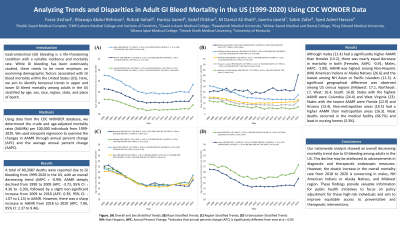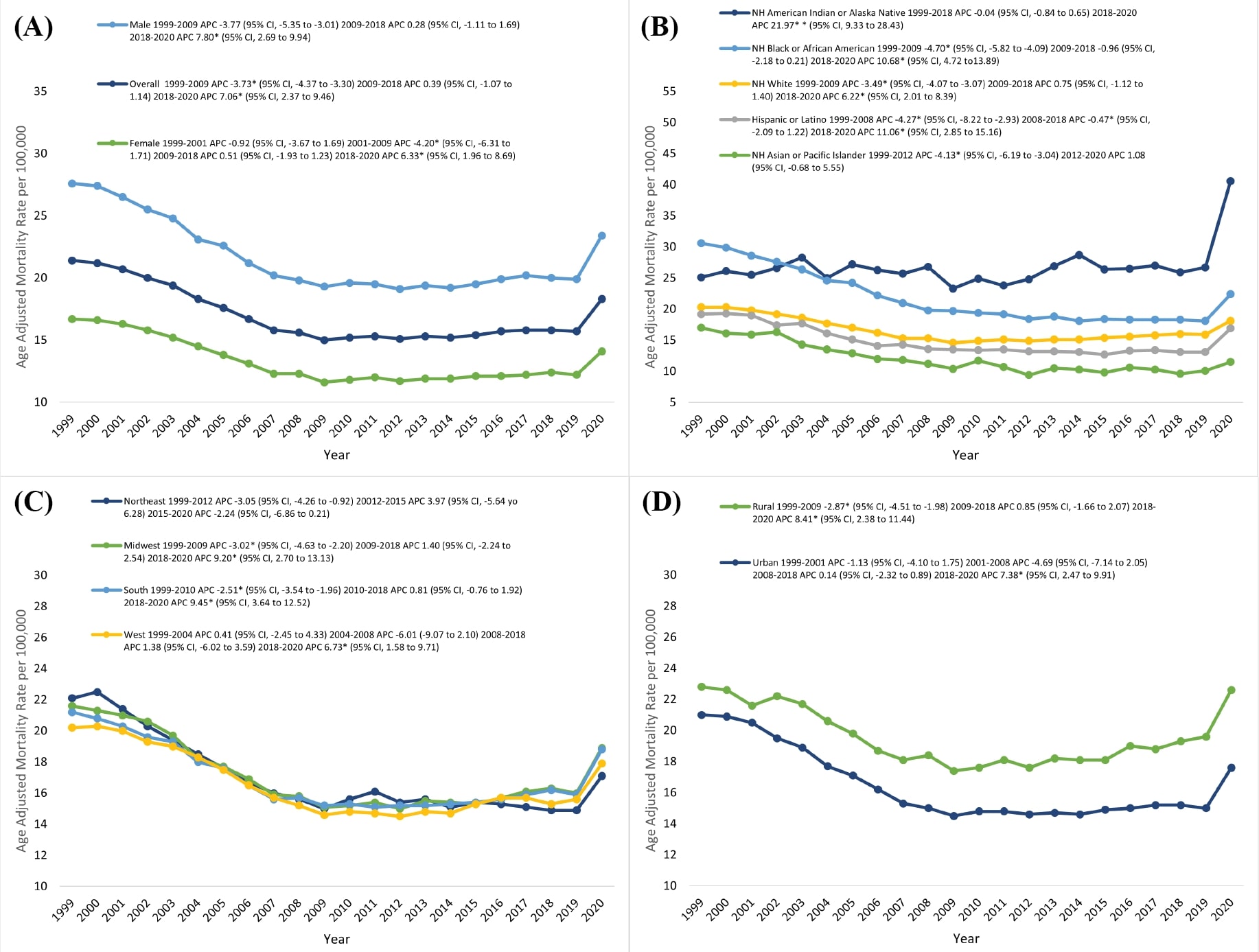Monday Poster Session
Category: GI Bleeding
P2459 - Analyzing Trends and Disparities in Adults GI Bleed Mortality in the US (1999-2020) Using CDC WONDER Data
Monday, October 28, 2024
10:30 AM - 4:00 PM ET
Location: Exhibit Hall E

Has Audio

Sadaf Iftikhar MD, MD
Akhtar Saeed Medical and Dental College
Al Dilam, Ar Riyad, Saudi Arabia
Presenting Author(s)
Faraz Arshad, MBBS1, Khawaja Abdul Rehman, MBBS2, Rohab Sohail, MBBS3, Humza Saeed, MBBS4, Sadaf Iftikhar MD, MD5, M Danial Ali Shah, MD6, Javeria Javeid, MBBS7, Sabin Zafar, MBBS8, Syed Adeel Hassan, MBBS9
1Shaikh Zayed Hospital, Gujrat, Punjab, Pakistan; 2CMH Lahore Medical College, Lahore, Punjab, Pakistan; 3Quaid-e-Azam Medical College, Bahawalpur, Punjab, Pakistan; 4Rawalpindi Medical University, Islamabad, Islamabad, Pakistan; 5Akhtar Saeed Medical and Dental College, Al Dilam, Ar Riyad, Saudi Arabia; 6King Edward Medical University, Lahore, Punjab, Pakistan; 7Allama Iqbal Medical College, Lahore, Punjab, Pakistan; 8Jinnah Sindh Medical University, Karachi, Sindh, Pakistan; 9University of Kentucky, Lexington, KY
Introduction: Gastrointestinal (GI) bleeding is a life-threatening condition with a variable incidence and mortality rate. While GI bleeding has been extensively studied, there needs to be more emphasis on examining demographic factors associated with GI bleed mortality within the United States (US). Here, we aim to identify temporal trends in upper and lower GI bleed mortality among adults in the US stratified by age, sex, race, region, state, and place of death
Methods: Using data from the CDC WONDER database, we determined the crude and age-adjusted mortality rates (AAMRs) per 100,000 individuals from 1999-2020. We used Joinpoint regression to examine the changes in AAMR through annual percent change (APC) and the average annual percent change (AAPC).
Results: A total of 80,3987 deaths were reported due to GI bleeding from 1999-2020 in the US, with an overall decreasing trend (AAPC = -0.99). AAMR steeply declined from 1999 to 2009 (APC: -3.73, 95% CI: -4.36 to -3.30), followed by a slight non-significant increase from 2009 to 2018 (APC: 0.39, 95% CI: -1.07 to 1.14) in AAMR. However, there was a sharp increase in AAMR from 2018 to 2020 (APC: 7.06, 95% CI: 2.37 to 9.46). Although males (21.4) had a significantly higher AAMR than females (13.2), there was nearly equal decrease in mortality in both (Females, AAPC: -0.91; Males, AAPC: -1.00). AAMR was highest among Non-Hispanic (NH) American Indians or Alaska Natives (26.6) and the lowest among NH Asian or Pacific Islanders (11.3). A significant geographical difference was observed among US census regions (Midwest: 17.1, Northeast: 17, West: 16.4, South: 16.8). States with highest AAMR were Columbia (24.4) and West Virginia (23). States with the lowest AAMR were Florida (12.9) and Arizona (13.4). Non-metropolitan areas (19.5) had a higher AAMR than metropolitan areas (16.3). Most deaths occurred in the medical facility (68.7%) and least in nursing homes (3.3%).
Discussion: Our nationwide analysis showed an overall decreasing mortality trend due to GI bleeding among adults in the US. This decline may be attributed to advancements in diagnostic and therapeutic endoscopic measures. However, the drastic increase in the overall mortality rate from 2018 to 2020 is concerning in males, NH American Indians or Alaska Natives, and Midwest region. These findings provide valuable information for public health initiatives to focus on policy adjustment for these high-risk individuals and aim to improve equitable access to preventative and therapeutic interventions

Disclosures:
Faraz Arshad, MBBS1, Khawaja Abdul Rehman, MBBS2, Rohab Sohail, MBBS3, Humza Saeed, MBBS4, Sadaf Iftikhar MD, MD5, M Danial Ali Shah, MD6, Javeria Javeid, MBBS7, Sabin Zafar, MBBS8, Syed Adeel Hassan, MBBS9. P2459 - Analyzing Trends and Disparities in Adults GI Bleed Mortality in the US (1999-2020) Using CDC WONDER Data, ACG 2024 Annual Scientific Meeting Abstracts. Philadelphia, PA: American College of Gastroenterology.
1Shaikh Zayed Hospital, Gujrat, Punjab, Pakistan; 2CMH Lahore Medical College, Lahore, Punjab, Pakistan; 3Quaid-e-Azam Medical College, Bahawalpur, Punjab, Pakistan; 4Rawalpindi Medical University, Islamabad, Islamabad, Pakistan; 5Akhtar Saeed Medical and Dental College, Al Dilam, Ar Riyad, Saudi Arabia; 6King Edward Medical University, Lahore, Punjab, Pakistan; 7Allama Iqbal Medical College, Lahore, Punjab, Pakistan; 8Jinnah Sindh Medical University, Karachi, Sindh, Pakistan; 9University of Kentucky, Lexington, KY
Introduction: Gastrointestinal (GI) bleeding is a life-threatening condition with a variable incidence and mortality rate. While GI bleeding has been extensively studied, there needs to be more emphasis on examining demographic factors associated with GI bleed mortality within the United States (US). Here, we aim to identify temporal trends in upper and lower GI bleed mortality among adults in the US stratified by age, sex, race, region, state, and place of death
Methods: Using data from the CDC WONDER database, we determined the crude and age-adjusted mortality rates (AAMRs) per 100,000 individuals from 1999-2020. We used Joinpoint regression to examine the changes in AAMR through annual percent change (APC) and the average annual percent change (AAPC).
Results: A total of 80,3987 deaths were reported due to GI bleeding from 1999-2020 in the US, with an overall decreasing trend (AAPC = -0.99). AAMR steeply declined from 1999 to 2009 (APC: -3.73, 95% CI: -4.36 to -3.30), followed by a slight non-significant increase from 2009 to 2018 (APC: 0.39, 95% CI: -1.07 to 1.14) in AAMR. However, there was a sharp increase in AAMR from 2018 to 2020 (APC: 7.06, 95% CI: 2.37 to 9.46). Although males (21.4) had a significantly higher AAMR than females (13.2), there was nearly equal decrease in mortality in both (Females, AAPC: -0.91; Males, AAPC: -1.00). AAMR was highest among Non-Hispanic (NH) American Indians or Alaska Natives (26.6) and the lowest among NH Asian or Pacific Islanders (11.3). A significant geographical difference was observed among US census regions (Midwest: 17.1, Northeast: 17, West: 16.4, South: 16.8). States with highest AAMR were Columbia (24.4) and West Virginia (23). States with the lowest AAMR were Florida (12.9) and Arizona (13.4). Non-metropolitan areas (19.5) had a higher AAMR than metropolitan areas (16.3). Most deaths occurred in the medical facility (68.7%) and least in nursing homes (3.3%).
Discussion: Our nationwide analysis showed an overall decreasing mortality trend due to GI bleeding among adults in the US. This decline may be attributed to advancements in diagnostic and therapeutic endoscopic measures. However, the drastic increase in the overall mortality rate from 2018 to 2020 is concerning in males, NH American Indians or Alaska Natives, and Midwest region. These findings provide valuable information for public health initiatives to focus on policy adjustment for these high-risk individuals and aim to improve equitable access to preventative and therapeutic interventions

Figure: Demographics and Regional Trends in GI Bleed-related AAMR among adults in the US, 1999-2020
(A) Trends in GI bleed-related AAMR, overall and stratified by sex among adults in the US, 1999-2020
(B) Trends in GI bleed-related AAMR stratified by race and ethnicity among adults in the US, 1999-2020
(C) Trends in GI bleed-elated AAMR stratified by Regions among adults in the US, 1999-2020
(D) Trends in GI bleed related AAMR stratified by rural and urban areas among adults in US, 1999-2020
(A) Trends in GI bleed-related AAMR, overall and stratified by sex among adults in the US, 1999-2020
(B) Trends in GI bleed-related AAMR stratified by race and ethnicity among adults in the US, 1999-2020
(C) Trends in GI bleed-elated AAMR stratified by Regions among adults in the US, 1999-2020
(D) Trends in GI bleed related AAMR stratified by rural and urban areas among adults in US, 1999-2020
Disclosures:
Faraz Arshad indicated no relevant financial relationships.
Khawaja Abdul Rehman indicated no relevant financial relationships.
Rohab Sohail indicated no relevant financial relationships.
Humza Saeed indicated no relevant financial relationships.
Sadaf Iftikhar MD indicated no relevant financial relationships.
M Danial Ali Shah indicated no relevant financial relationships.
Javeria Javeid indicated no relevant financial relationships.
Sabin Zafar indicated no relevant financial relationships.
Syed Adeel Hassan indicated no relevant financial relationships.
Faraz Arshad, MBBS1, Khawaja Abdul Rehman, MBBS2, Rohab Sohail, MBBS3, Humza Saeed, MBBS4, Sadaf Iftikhar MD, MD5, M Danial Ali Shah, MD6, Javeria Javeid, MBBS7, Sabin Zafar, MBBS8, Syed Adeel Hassan, MBBS9. P2459 - Analyzing Trends and Disparities in Adults GI Bleed Mortality in the US (1999-2020) Using CDC WONDER Data, ACG 2024 Annual Scientific Meeting Abstracts. Philadelphia, PA: American College of Gastroenterology.
